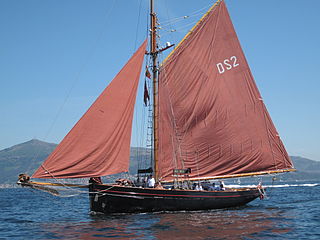
A catboat is a sailboat with a single sail on a single mast set well forward in the bow of a very beamy and (usually) shallow draft hull. Typically they are gaff rigged, though Bermuda rig is also used. Most are fitted with a centreboard, although some have a keel. The hull can be 3.7 to 12.2 metres long with a beam half as wide as the hull length at the waterline. The type is mainly found on that part of the Eastern seaboard of the USA from New Jersey to Massachusetts.
Bruce Kenneth Farr is a New Zealand designer of racing and cruising yachts. Farr‑designed boats have won, challenged for, or placed highly in the Whitbread Round the World Race, America's Cup, and Sydney to Hobart Yacht Race, among others.

Jolie Brise is a gaff-rigged pilot cutter built and launched by the Albert Paumelle Yard in Le Havre in 1913 to a design by Alexandre Pâris. After a short career as a pilot boat, owing to steam replacing sail, she became a fishing boat, a racing yacht and a sail training vessel.

Rona was a sailing yacht designed by George Lennox Watson. She was constructed in 1892 in Auckland, New Zealand, by master craftsman and designer Robert Logan Snr. for Wellington merchant and book collector Alexander Turnbull, and is the oldest continuously registered ship in New Zealand.

The Royal New Zealand Yacht Squadron is a New Zealand yacht club, and the club behind New Zealand's America's Cup campaigns, under the guises of New Zealand Challenge and Team New Zealand. It held the America's Cup from 1995 until 2003, becoming in 2000 the first non-American holder to successfully defend the trophy. After Team New Zealand's victory in the 2017 event, the Royal New Zealand Yacht Squadron are the current holders of the America's Cup. On March 21, 2021, they beat Circolo della Vela Sicilia's Luna Rossa Challenge to again win the 2021 America's Cup.

A sailing yacht, is a leisure craft that uses sails as its primary means of propulsion. A yacht may be a sail or power vessel used for pleasure, cruising, or racing. There is no standard definition, so the term applies here to sailing vessels that have a cabin with amenities that accommodate overnight use. To be termed a "yacht", as opposed to a "boat", such a vessel is likely to be at least 33 feet (10 m) in length and have been judged to have good aesthetic qualities. Sailboats that do not accommodate overnight use or are smaller than 30 feet (9.1 m) are not universally called yachts. Sailing yachts in excess of 130 feet (40 m) are generally considered to be superyachts.
The Tasmanian One Design is a class of Australian sail boat.
Archibald Arch Logan was a New Zealand sailing yacht designer who was a leading figure in New Zealand yachting from approximately 1895 until his death. The Arch Logan Memorial Trophy named in his honour is the premier trophy of the New Zealand M class centreboard racing dinghy sailing completions.
Yachting New Zealand is recognised by World Sailing as the governing body for the sport of sailing in New Zealand. Yachting New Zealand also facilitates training in sailing in and around the country.
Robert Logan Senior (1837–1919) was a notable boat builder and the founder of the Logan boat building and boat designing dynasty.
Logan Brothers was a firm of boat and yacht design and builders. Although their Auckland yard lasted only from 1890 to 1910, it was the most significant yacht- and boat-building business in the Southern Hemisphere during its time, dominating the New Zealand market and exporting vessels to Australia, South Africa and to the Pacific Islands.

Akarana is a racing yacht which was built in Auckland, New Zealand in 1888 by Robert Logan (Senior) to represent that country in the Australian Centennial Regatta held on Hobson's Bay, Victoria. She was restored as New Zealand's bicentenary gift to Australia and is today currently the oldest vessel in the collection of the Australian National Maritime Museum.

The C&C Custom 67 is a Canadian sailboat, that was designed by Robert W. Ball of C&C Yachts and was launched and named Archangel in September 1980. She remains the largest pleasureboat commission ever received by C&C, and epitomized a trend within C&C during the later 1970s and early 1980s toward more cruising-oriented designs under George Cuthbertson's direction, a trend best illustrated by the development of the Landfall series.
The Aquarius 24 Pilot Cutter, also called the Aquarius Pilot Cutter 24, Aquarius 24 Cutter and the Topsail Pilot Cutter, is an American trailerable sailboat that was designed by Frank Parish as a cruiser and first built in 1979.
The Cal 2-24, also called the Cal 24-2 and the Cal 24 Mark II is an American trailerable sailboat that was designed by C. William Lapworth as a racer and first built in 1967.
The Captiva 240 is an American trailerable sailboat that was first built in 1984. The boat is a development of the O.H. Rodgers-designed Rodgers 24 racer, modified for use as a racer-cruiser by Walter Scott by giving it a new keel and sailing rig.
The Cornish Crabber 24 is a series of British trailerable sailboats, designed by Roger Dongray as cruisers and first built in 1974.
The Mark 25 is an American trailerable sailboat that was designed by Canadian George Harding Cuthbertson, as one of the first works under his new design firm Motion Designs Limited after he left C&C Design. The boat was intended as a racer-cruiser and first built in 1984.

The Pearson 24 is an American trailerable sailboat that was designed by William Shaw as a cruiser and first built in 1967.
The S2 6.8 is an American trailerable sailboat that was designed by Don Wennersten and Arthur Edmunds as a racer-cruiser and first built in 1976. The designation indicates the approximate length overall in meters.








